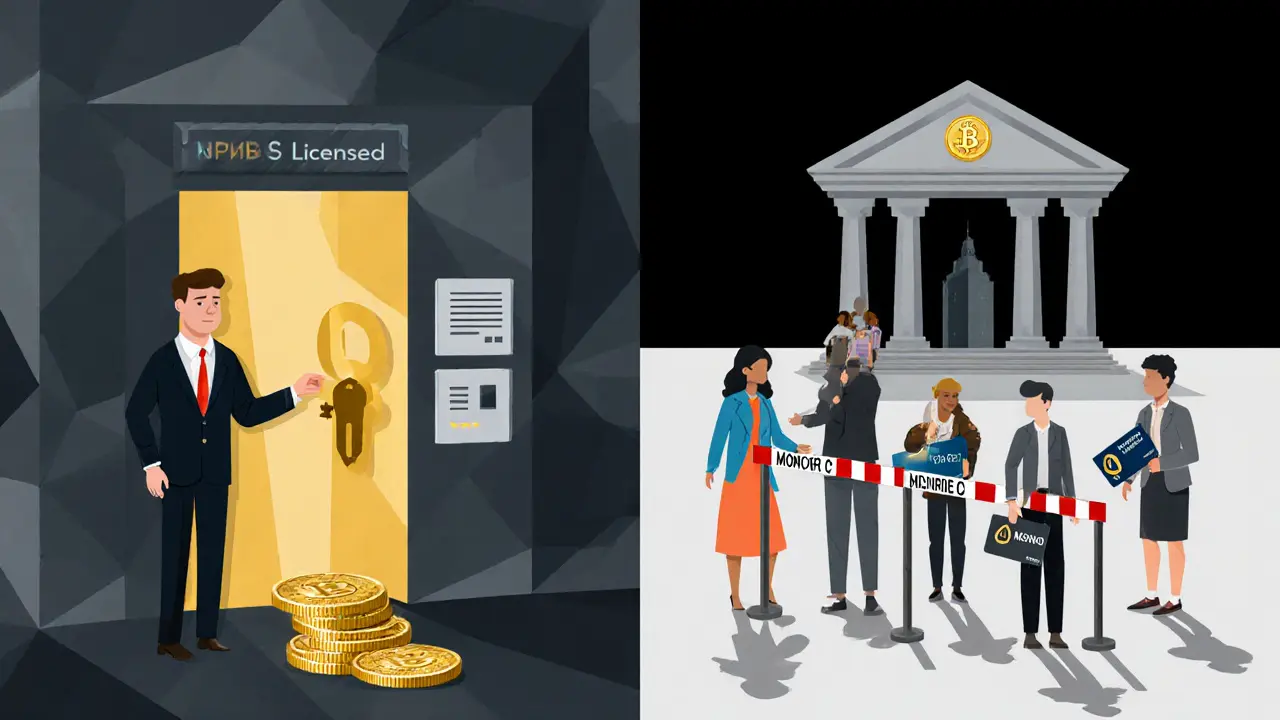Crypto Trading Calculator
Transaction Calculator
Calculate how many transactions and time are needed to move rubles under Russia's 50,000 ruble withdrawal limit
Results
How this works: Russia limits cash withdrawals to 50,000 rubles. Each transaction requires 48 hours before the next can be processed. This calculator shows how many transactions and time would be needed to move large amounts under the new rules.
Russia’s new cash withdrawal rules are breaking Bitcoin trading
Since September 1, 2025, Russian banks have been forced to block cash withdrawals over 50,000 rubles ($600) for 48 hours if they detect anything unusual. That sounds like a fraud-fighting measure-and it is. But for thousands of Russians who trade Bitcoin and other cryptocurrencies, it’s become a wall. Most crypto deals in Russia still happen through cash. Small exchange kiosks, P2P traders, and even miners rely on in-person cash swaps. Now, those deals are stuck. You can’t sell 200,000 rubles worth of Bitcoin in one go. You can’t even do it over two days without triggering a bank alert.
Why cash is the lifeblood of Russian crypto
After sanctions hit in 2022, Russians turned to crypto not just for profit, but for survival. Western payment systems like Visa and Mastercard were cut off. Banks froze accounts. People needed a way to move value without government oversight. Bitcoin became the go-to. But Bitcoin doesn’t pay rent. So traders found a workaround: cash. You meet someone at a café, hand over 100,000 rubles in bills, and get Bitcoin sent to your wallet. Simple. Fast. Untraceable. That’s how the system worked-until September 2025.
The Central Bank of Russia now flags any transaction that looks out of place: a new phone number linked to your account, a sudden loan followed by a cash withdrawal, or multiple transfers over 200,000 rubles between accounts. Even using a QR code to pay for crypto can trigger a freeze. Banks are watching every move. And they’re not wrong-fraud cases jumped to 273,000 in just three months, totaling over 6 billion rubles. But the cure is hurting the healthy.
How traders are adapting: digital workarounds
People aren’t giving up. They’re just changing tactics.
- Foreign exchanges are filling the gap-Platforms like Binance, Kraken, and Bybit still let Russians create accounts. You can buy Bitcoin with a bank transfer, even if your local bank is watching. The catch? You can’t cash out easily. But many are using virtual cards or crypto-to-crypto swaps to move funds abroad.
- P2P platforms are shifting to bank transfers-Instead of meeting for cash, traders now use instant bank transfers. They’ll list a Bitcoin offer with a note: “Only bank transfer, no cash.” Buyers with clean transaction histories get approved faster. It’s slower, but it works.
- Stablecoins are replacing cash-Tether (USDT) is now the most traded crypto in Russia. It’s pegged to the dollar, so it holds value. Traders buy USDT with rubles, then send it to a friend overseas. The friend sells it for dollars. No cash. No bank flags.
- Miners are turning to mining pools with payout in crypto-Before, miners sold their Bitcoin directly to local buyers for cash. Now, they’re joining mining pools that pay out in Bitcoin or USDT. Then they use foreign exchanges to cash out. Some even use crypto debit cards from non-Russian providers to spend their earnings abroad.

The rise of the “qualified investor” loophole
Russia has a secret rule: only people with over 100 million rubles in assets (about $1.2 million) are allowed to legally trade crypto under a government-approved experimental program. It’s not a ban on crypto-it’s a ban on ordinary people. The government wants crypto for international trade and sanctions evasion, but not for everyday Russians. So if you’re rich, you can buy Bitcoin legally through licensed platforms. If you’re not? You’re stuck in the gray zone.
This creates a two-tier system. The wealthy trade crypto openly. The rest trade in shadows. And the government knows it. That’s why lawmakers are now pushing to license domestic exchanges. In August 2025, a group of MPs asked the Central Bank to let local platforms operate under strict rules. The CBR refused. But the pressure is growing.
What’s next? The crypto bank idea
Evgeny Masharov, a member of Russia’s Civic Chamber, has a bold proposal: create a state-backed crypto bank. Think of it like a regular bank-but you can deposit Bitcoin, withdraw rubles, and send crypto internationally. It would bring underground trading into the light, help track fraud, and even generate tax revenue. Russia already has the infrastructure. It just needs the political will.
Meanwhile, mining is still alive. Even though 10 regions banned crypto mining in January 2025, the industry hasn’t collapsed. Prostomining reported that miners are relocating to Siberia and the Far East, where electricity is cheap and oversight is thin. The Blockchain Forum in Moscow drew record attendance in October 2025. The demand is there. The rules are just catching up.
Alternatives to Bitcoin: what Russians are using instead
Bitcoin isn’t the only option anymore. Here’s what’s gaining traction:
- USDT (Tether)-The most popular. Easy to move across borders, stable value, accepted everywhere.
- Monero (XMR)-Privacy-focused. Harder to trace. Used by traders who still want anonymity.
- Ethereum (ETH)-Used for DeFi swaps and smart contracts. Less cash-dependent.
- Ruble-backed tokens-A few local projects are launching tokens pegged to the ruble. They’re not legal, but they’re circulating in Telegram groups. Risky, but useful for short-term transfers.
Most traders now hold a mix: USDT for transfers, Bitcoin for long-term value, and Monero for privacy-heavy deals.

The real cost: trust and time
The biggest casualty isn’t money-it’s trust. People used to meet for cash trades with a handshake. Now, they’re sending screenshots of bank confirmations, waiting 24 hours for transfers to clear, and double-checking transaction IDs. Trades that took 10 minutes now take 3 days. The convenience is gone. The risk is higher. And the fear of being flagged is constant.
One trader in Novosibirsk told me he now uses three different bank accounts-each with different transaction patterns-just to avoid detection. Another uses a friend’s account in Kazakhstan to receive crypto payouts, then moves the money back through a series of small transfers. It’s not elegant. But it works.
Will this ban last?
Probably not. The restrictions were meant to stop fraud, not stop crypto. But they’ve done both. The Central Bank claims fraud is dropping. But trade volume has fallen 40% since September. The economy still needs crypto for international payments. Companies are still buying Bitcoin to pay suppliers in Asia. The government can’t ignore that.
By mid-2026, expect a shift. Either the withdrawal limits will be relaxed, or a legal crypto banking system will be launched. Until then, Russians are doing what they’ve always done: finding a way around.
What you can learn from this
If you’re trading crypto in a country with strict controls, don’t rely on cash. Build digital alternatives now. Use stablecoins. Learn how to move funds across borders legally. Know your bank’s red flags. And never assume the rules won’t change. Russia’s crypto ban wasn’t sudden-it was inevitable. The smart traders saw it coming. The ones who didn’t? They’re still waiting for their next cash deal to clear.
Can I still buy Bitcoin in Russia legally?
Yes, but only if you’re a qualified investor with over 100 million rubles in assets. For everyone else, buying Bitcoin isn’t illegal-but there are no licensed local exchanges. Most people use foreign platforms like Binance or Kraken with bank transfers or virtual cards. The government doesn’t block access to these sites, but it makes cashing out very hard.
Why are cash withdrawals limited to 50,000 rubles?
The Central Bank set this limit to fight fraud. In 2025, over 6 billion rubles were stolen through fake withdrawals, loan scams, and money laundering. The rule targets patterns: sudden large cash withdrawals, new phone numbers, or transfers right after getting a loan. It’s not meant to stop crypto-but that’s what it did, because crypto traders relied on cash.
Are Russian crypto miners still active?
Yes. Even though 10 regions banned mining in January 2025, the industry is adapting. Miners are moving to Siberia and the Far East, where electricity is cheaper and enforcement is weaker. Many now use mining pools that pay out in Bitcoin or USDT, then cash out through foreign exchanges. The Blockchain Forum in Moscow had its biggest turnout in October 2025, showing the sector is still growing.
What’s the safest way to trade crypto in Russia today?
Use USDT on foreign exchanges like Binance. Send it to a trusted contact abroad, and have them convert it to dollars or euros. Avoid cash trades entirely. Use bank transfers only if your account has a clean history. Never use QR codes or new phone numbers for crypto payments-they trigger bank alerts. Keep small, regular transactions to avoid suspicion.
Will Russia ever legalize crypto for regular people?
It’s likely. Lawmakers are pushing for licensed exchanges, and the finance ministry wants to bring crypto into the formal economy. But the Central Bank still opposes it. The real change will come when the government realizes it can’t control crypto-it can only regulate it. A state-backed crypto bank is the most probable path forward, possibly by late 2026.

Rajesh pattnaik
November 26, 2025 AT 07:16Love how they’re using USDT like digital cash. Smart move.
Lisa Hubbard
November 28, 2025 AT 02:33preet kaur
November 28, 2025 AT 22:25Still, the fact that miners are moving to Siberia? That’s resilience. People adapt. That’s the real story here-not the bans, but the quiet hustle.
Amanda Cheyne
November 30, 2025 AT 11:39They’re watching your QR codes because they’re scared. Scared that you’ll realize you don’t need them. And that’s why this will backfire. Mark my words.
David Hardy
December 1, 2025 AT 20:48This is the most badass underground economy I’ve ever seen. Like, imagine being this creative just to buy Bitcoin. Respect. 🙌
Also, Monero for privacy deals? Yes. Yes. Yes.
Matthew Prickett
December 3, 2025 AT 04:44They’re not trying to stop crypto. They’re trying to make you pay for it. Every. Single. Transaction. And then they’ll tax you on your ‘unreported gains.’
They’re building the panopticon, and you’re still trading USDT like it’s free.
Gus Mitchener
December 4, 2025 AT 07:08Thus, the withdrawal limit is not a regulatory instrument per se, but a performative failure of the state’s epistemic authority over value. The system is not broken-it is being outmaneuvered by a decentralized episteme that operates outside the hermeneutic frame of fiat logic.
USDT is not currency. It is a semantic bridge between incompatible ontologies.
Jennifer Morton-Riggs
December 5, 2025 AT 06:14And USDT? Yeah, that’s the new dollar. Everyone’s just pretending it’s not happening. Meanwhile, my cousin in Ukraine is using it to pay her mom’s medical bills. But hey, at least the Central Bank is ‘fighting fraud.’ 🙄
Kathy Alexander
December 6, 2025 AT 22:08And Monero? That’s just a tool for criminals. You’re glorifying anonymity when the whole point of finance is transparency. Maybe if you didn’t want to hide, you wouldn’t need to bypass 12 layers of workarounds.
Soham Kulkarni
December 6, 2025 AT 23:36also pls dont use qr codes. i lost 50k last month cause bank flagged it. now i only do small bank transfers. its slow but safe.
Tejas Kansara
December 7, 2025 AT 14:53Stick to bank transfers. Avoid QR codes. Don’t use new numbers.
Simple. Done.
Belle Bormann
December 8, 2025 AT 04:43Also, USDT is the MVP here. I’ve been telling my friends to use it instead of Bitcoin for transfers. It’s so much smoother. Just don’t send big amounts all at once!
Sky Sky Report blog
December 9, 2025 AT 20:44What is needed is not a crypto bank, but a redefinition of financial sovereignty. Until then, the underground economy will continue to thrive, not because of defiance, but because it serves a functional need the state refuses to acknowledge.
Jenny Charland
December 9, 2025 AT 21:12Using your friend’s account in Kazakhstan? That’s money laundering 101. And you’re proud of it?
At least in the US, we have laws. You think you’re free? You’re just a walking compliance risk.
Emily Michaelson
December 10, 2025 AT 09:59The real takeaway? If you’re in a country with heavy financial controls, don’t wait for permission. Build your digital alternatives now. Stablecoins. Foreign exchanges. Decentralized bridges.
It’s not about being a rebel. It’s about being prepared.